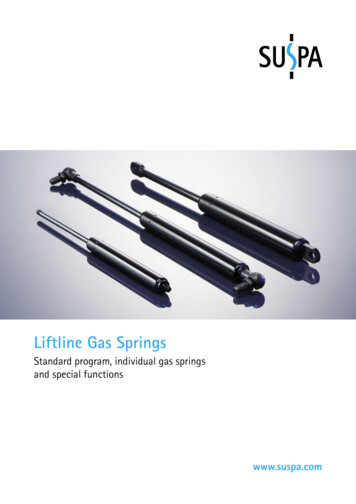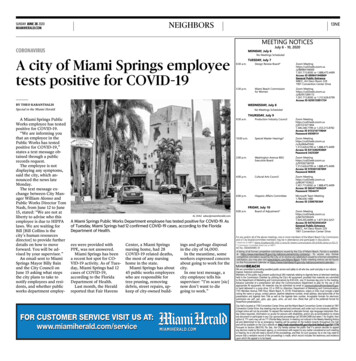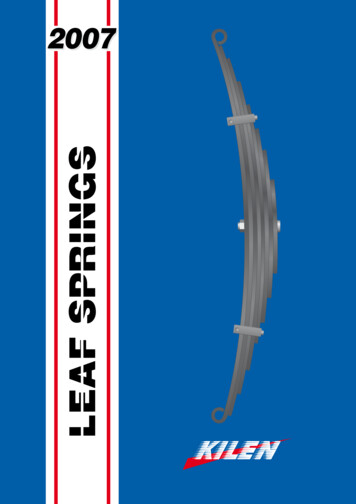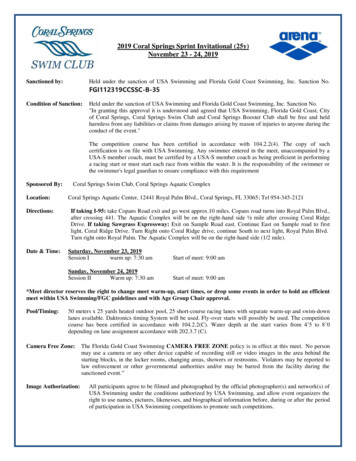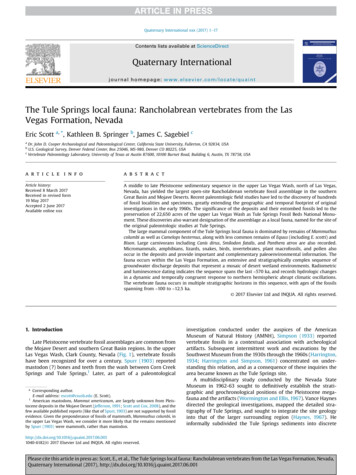
Transcription
Quaternary International xxx (2017) 1e17Contents lists available at ScienceDirectQuaternary Internationaljournal homepage: www.elsevier.com/locate/quaintThe Tule Springs local fauna: Rancholabrean vertebrates from the LasVegas Formation, NevadaEric Scott a, *, Kathleen B. Springer b, James C. Sagebiel caDr. John D. Cooper Archaeological and Paleontological Center, California State University, Fullerton, CA 92834, USAU.S. Geological Survey, Denver Federal Center, Box 25046, MS-980, Denver CO 80225, USAcVertebrate Paleontology Laboratory, University of Texas at Austin R7600, 10100 Burnet Road, Building 6, Austin, TX 78758, USAba r t i c l e i n f oa b s t r a c tArticle history:Received 8 March 2017Received in revised form19 May 2017Accepted 2 June 2017Available online xxxA middle to late Pleistocene sedimentary sequence in the upper Las Vegas Wash, north of Las Vegas,Nevada, has yielded the largest open-site Rancholabrean vertebrate fossil assemblage in the southernGreat Basin and Mojave Deserts. Recent paleontologic field studies have led to the discovery of hundredsof fossil localities and specimens, greatly extending the geographic and temporal footprint of originalinvestigations in the early 1960s. The significance of the deposits and their entombed fossils led to thepreservation of 22,650 acres of the upper Las Vegas Wash as Tule Springs Fossil Beds National Monument. These discoveries also warrant designation of the assemblage as a local fauna, named for the site ofthe original paleontologic studies at Tule Springs.The large mammal component of the Tule Springs local fauna is dominated by remains of Mammuthuscolumbi as well as Camelops hesternus, along with less common remains of Equus (including E. scotti) andBison. Large carnivorans including Canis dirus, Smilodon fatalis, and Panthera atrox are also recorded.Micromammals, amphibians, lizards, snakes, birds, invertebrates, plant macrofossils, and pollen alsooccur in the deposits and provide important and complementary paleoenvironmental information. Thefauna occurs within the Las Vegas Formation, an extensive and stratigraphically complex sequence ofgroundwater discharge deposits that represent a mosaic of desert wetland environments. Radiometricand luminescence dating indicates the sequence spans the last 570 ka, and records hydrologic changesin a dynamic and temporally congruent response to northern hemispheric abrupt climatic oscillations.The vertebrate fauna occurs in multiple stratigraphic horizons in this sequence, with ages of the fossilsspanning from 100 to 12.5 ka. 2017 Elsevier Ltd and INQUA. All rights reserved.1. IntroductionLate Pleistocene vertebrate fossil assemblages are common fromthe Mojave Desert and southern Great Basin regions. In the upperLas Vegas Wash, Clark County, Nevada (Fig. 1), vertebrate fossilshave been recognized for over a century. Spurr (1903) reportedmastodon (?) bones and teeth from the wash between Corn CreekSprings and Tule Springs.1 Later, as part of a paleontological* Corresponding author.E-mail address: escott@csusb.edu (E. Scott).1American mastodons, Mammut americanum, are largely unknown from Pleistocene deposits in the Mojave Desert (Jefferson, 1991; Scott and Cox, 2008), and thefew available published reports (like that of Spurr, 1903) are not supported by fossilevidence. Given the preponderance of fossils of mammoth, Mammuthus columbi, inthe upper Las Vegas Wash, we consider it more likely that the remains mentionedby Spurr (1903) were mammoth, rather than mastodon.investigation conducted under the auspices of the AmericanMuseum of Natural History (AMNH), Simpson (1933) reportedvertebrate fossils in a contextual association with archeologicalartifacts. Subsequent intermittent work and excavations by theSouthwest Museum from the 1930s through the 1960s (Harrington,1934; Harrington and Simpson, 1961) concentrated on understanding this relation, and as a consequence of these inquiries thearea became known as the Tule Springs site.A multidisciplinary study conducted by the Nevada StateMuseum in 1962-63 sought to definitively establish the stratigraphic and geochronological positions of the Pleistocene megafauna and the artifacts (Wormington and Ellis, 1967). Vance Haynesdirected the geological investigations, mapped the detailed stratigraphy of Tule Springs, and sought to integrate the site geologyinto that of the larger surrounding region (Haynes, 1967). Heinformally subdivided the Tule Springs sediments into .0011040-6182/ 2017 Elsevier Ltd and INQUA. All rights reserved.Please cite this article in press as: Scott, E., et al., The Tule Springs local fauna: Rancholabrean vertebrates from the Las Vegas Formation, Nevada,Quaternary International (2017), http://dx.doi.org/10.1016/j.quaint.2017.06.001
2E. Scott et al. / Quaternary International xxx (2017) 1e17Fig. 1. (a) Site location map for the Las Vegas Valley of southern Nevada (red star); (b) aerial photograph of the Las Vegas Valley showing major physiographic features and the lightcolored paleowetland deposits that are exposed in large parts of the upper Las Vegas Wash, including much of Tule Springs Fossil Beds National Monument (TUSK). (For interpretation of the references to colour in this figure legend, the reader is referred to the web version of this article.)stratigraphic units, and referred to them where they occurred in theLas Vegas Valley proper as the “Las Vegas Formation” afterLongwell et al. (1965). Mawby (1967) described the vertebrate remains from Tule Springs and discussed them within the informalunits described by Haynes. The ultimate determination of theexpedition was that human cultural artifacts were not in atemporally contextual position with respect to the vertebratemegafauna (Wormington and Ellis, 1967), and further investigations were suspended.Few scientific inquires occurred in the Tule Springs area for thenext four decades, save for some regional investigations focusedon the mode and timing of paleoclimatic and hydrologic indicatorsof high groundwater discharge (paleospring deposits) in thesouthern Great Basin (Quade, 1983, 1986; Quade and Pratt, 1989;Quade et al., 1995, 1998, 2003). Vertebrate fossils recognized fromthese paleospring lithologies were little studied or reported upon.From the 1990s to the present, scientists from the San Bernardino County Museum (SBCM) (Reynolds et al., 1991a; Springer et al.,2006, 2015; Scott and Springer, 2016), under permits from theSouthern Nevada District Office of the Bureau of Land Management(BLM), discovered and documented hundreds of fossil localities,and added new taxa to the faunas described by Simpson (1933) andMawby (1967). These ongoing paleontologic investigations,coupled with expanded and better-defined geologic interpretationsand more refined dating of older sedimentary units (Page et al.,2005; Ramelli et al., 2011, 2012; Springer et al., 2015, 2017), haveled to the determination that the assemblage of invertebrate andvertebrate fossil remains from the upper Las Vegas Wash comprisesone of the most informative and significant late Pleistocene assemblages in the region.The vertebrate fauna is derived from multiple discrete stratigraphic horizons within the middle to late Pleistocene Las VegasFormation. The nature of this assemblage matches published definitions for local faunas; it is “local in both time and space” (afterTaylor, 1960:10), consisting of “samples derived from localities,sites, quarries, pits, prospects, etc.” that can be “organized intoaggregates of species which have a distribution in time andspace, based on the record from a restricted geographic area”(Tedford, 1970:686). Based upon these definitions, and because ofthe importance of these remains, this late Pleistocene assemblagewarrants designation as a local fauna, herein named the TuleSprings local fauna (TSLF).2. Background2.1. Geologic setting and age of the fossil assemblageThe broad sedimentary basin of the Las Vegas Valley was createdduring the Neogene by extensional forces associated with the formation of the Basin and Range province of western North America(Fleck, 1970; Page et al., 2005). Normal and strike-slip faults cutacross the region, including the Las Vegas Valley Shear Zone(LVVSZ), a northwest-striking, right lateral strike-slip fault system(Langenheim et al., 1997, 1998; Page et al., 2005). Thick basin-filldeposits mostly bury the LVVSZ, although surface expression occurs at Corn Creek Springs. The LVVSZ also marks the headwarderosion of the upper Las Vegas Wash, and includes discontinuitiesand subsurface barriers that likely influence local and regionalgroundwater flow patterns.The Quaternary-age Las Vegas Formation was first mapped anddescribed by Longwell et al. (1965) from a series of light-coloredclay and silt deposits exposed along the upper Las Vegas Wash.Due to their highly fossiliferous nature, including a number ofextinct vertebrates, Longwell (1946) assigned the sedimentarysequence to the Pleistocene. Prior to extensive urbanization of thecities of Las Vegas and North Las Vegas, these sediments wereexposed throughout the Las Vegas Valley (Longwell et al., 1965;Haynes, 1967; Matti et al., 1993; Donovan, 1996; Bell et al., 1998,1999; Page et al., 2005). Today, exposures are primarily restricted tothe upper Las Vegas Wash and Corn Creek Flat areas, coincidentwith the boundaries of Tule Springs Fossil Beds National Monument (Fig. 1).At the original Tule Springs site, Haynes (1967) recognized anddescribed five Pleistocene and two Holocene informal stratigraphicunits (A-G, in ascending stratigraphic order with subunits designated with subscript numerals) and six intervening soils. HePlease cite this article in press as: Scott, E., et al., The Tule Springs local fauna: Rancholabrean vertebrates from the Las Vegas Formation, Nevada,Quaternary International (2017), http://dx.doi.org/10.1016/j.quaint.2017.06.001
E. Scott et al. / Quaternary International xxx (2017) 1e17attributed these informal units to the Las Vegas Formation, ascoined by Longwell et al. (1965), and subsequently this usage wasextrapolated throughout the upper Las Vegas Valley (Quade, 1986).Through successive periods of dissection, deflation, and deposition, the formational units are laterally discontinuous, exhibitcomplex stratigraphic relations, and form a highly dissected,badland topography. Longwell et al. (1965) mapped the Las VegasFormation as Quaternary lacustrine (Ql) based on the thin, regularand horizontal bedding, and together with the nature and abundance of fossil mollusk shells, interpreted the sediments as representing shallow lakes that once occupied the Las Vegas Valley.Others have also attributed these extensive deposits in the LasVegas Valley to be strictly lacustrine in origin (Hubbs and Miller,1948; Maxey and Jameson, 1948; Snyder et al., 1964; Longwellet al., 1965). Haynes (1967) determined that at least some of the negas, or desert wetlands,sediments were deposited in ciealthough he too postulated the existence of “Pluvial Lake LasVegas” based on the spatial distribution of full-glacial age depositsin the Las Vegas Valley. More recent studies have demonstratedthat the sediments were deposited during past episodes ofgroundwater discharge, and thus the existence of “Pluvial Lake LasVegas” is no longer accepted (Quade, 1986; Springer et al., 2015,2017).Springer et al. (2017) established the contemporary frameworkfor the fossil-bearing groundwater discharge deposits (GWD) in theLas Vegas Valley with detailed geologic mapping, and stratigraphicand chronologic control aided by numerous 14C and luminescencedates throughout the sedimentary sequence. Springer et al. (2017)also designated the Las Vegas Formation as a formal lithostratigraphic unit, with distinct and mappable members and beds. Thenomenclature largely follows that of Haynes (1967) but with significant modifications to the lithostratigraphy and geochronology.The Las Vegas Formation now includes Members X, A, B, D, and E,which represent distinct groundwater discharge regimes andcontain vertebrate and/or invertebrate fossils. Units F and G ofHaynes (1967) are excluded as they represent dry conditions thatprevailed during the Holocene and do not contain vertebrate materials. In addition, Unit C of Haynes (1967) has been dissolvedbased on revised stratigraphic and chronologic data and observations. In all, the GWD deposits of the Las Vegas Formation span thepast 570,000 ka.The TSLF, within the Las Vegas Valley, occurs in 13 distinct bedswithin Members B, D and E. The primary physical characteristics,age ranges, and distribution of vertebrate fossils for each subunitwithin the Las Vegas Formation are presented herein as a composite stratigraphy (Fig. 2). Additional stratigraphic and chronologic details for all subunits are provided in Springer et al. (2017).Overall, the ages of fossil-bearing strata within the Las Vegas Formation span from 100 to 12.5 ka.2.2. Paleoenvironment and paleoclimateDuring the middle-late Pleistocene, a climate cooler andwetter than today supported a variety of groundwater dischargesettings throughout the southwestern U.S., including seeps,springs, marshes, wet meadows, ponds, and spring pools. Alluvial, fluvial, and eolian sediment became trapped by wet groundconditions and dense plant cover around discharge points, andcombined with organic material and chemical precipitates (carbonates, silicates) to form GWD deposits (Pigati et al., 2014).These deposits are distinguished from lake sediments usinggeomorphic, sedimentologic, and stratigraphic properties, and weare able to recognize specific hydrologic regimes within the3deposits that are analogous to modern spring ecosystems(Springer and Stevens, 2008). Evidence for limnocrene (ponding),helocrene (marshes or wet meadows), and rheocrene (spring-fedstream) flow is recognized within the Las Vegas Formation GWDsequence. The types of spring discharge and their spatial distribution throughout the upper Las Vegas Wash are directly relatedto subsurface structure (faults), aquifer complexity, and local andregional water table levels. The recognition of specific hydrologicenvironments within a given member or bed allows pastenvironmental and hydrologic conditions to be furtherconstrained.The highly resolved chronologic and paleohydrologic record ofthe GWD deposits in the upper Las Vegas Wash shows that wetlands in the valley were extremely sensitive to climate changeduring the recent geologic past (Springer et al., 2015). Over the last35 ka, for example, multiple cycles of deposition, erosion, and soilformation demonstrate that wetland ecosystems in the valleyexpanded and contracted many times, often collapsing entirely,before disappearing altogether as the last glacial period came to aclose. These events exhibit temporal congruence with episodes ofabrupt climate change, including Dansgaard-Oeschger (D-O) cyclesand other millennial and submillennial-scale climatic perturbations (Fig. 3). Drought-like conditions, as recorded by widespreaderosion and the formation of desert soils, typically lasted for a fewcenturies, which would have severely impacted the flora and faunathat depended on the springs and wetlands for water in an otherwise arid landscape. The TSLF occurs throughout the members andbeds of the Las Vegas Formation, each of which represents adiscrete “bin of time” that can be queried to evaluate changes inlocal faunal assemblages, reconstruct past ecosystems and environments on millennial and submillennial timescales, and determine the response of these systems to past episodes of abruptclimate change.2.3. Recent history of investigationThe San Bernardino County Museum (SBCM) recovered fossilsand associated contextual data from Tule Springs and the upperLas Vegas Wash from 2002 to 2014. Initial survey and excavationefforts were conducted in conjunction with the mitigation program for the Harry AlleneNorthwest 500 kV transmission line(HANWTL) in North Las Vegas, under Paleontologic Resources UsePermits #N75218 (for survey) and #N76154 (for excavation) fromthe BLM, as well as under the auspices of Nevada AntiquitiesPermit #449.The paleontologic sensitivity of the Las Vegas Formation in theupper Las Vegas Wash later assumed particular significance whenthe wash was included in the Las Vegas Valley Disposal Boundary(LVVDB). The LVVDB comprised public lands administered by theBLM that were slated to be disposed of by the Las Vegas Field Office,consistent with the Southern Nevada Public Land Management Actof 1998 (SNPLMA). However, the SNPLMA did not authorize theBLM to transfer title of land if such transfer would not conform toother laws, including the National Environmental Policy Act of 1970(NEPA).An Environmental Impact Statement (EIS) was completed toupdate the BLM's analysis of SNPLMA land sales and other BLMauthorized land uses in light of the requirements of NEPA and theBLM's NEPA Handbook, and to analyze impacts of disposing andauthorizing uses of federal public lands within the new disposalboundary adopted by the U.S. Congress. As part of this effort, theSBCM field surveyed the entire LVVDB, including much of the upperLas Vegas Wash, in 2003e2004. This survey resulted in thePlease cite this article in press as: Scott, E., et al., The Tule Springs local fauna: Rancholabrean vertebrates from the Las Vegas Formation, Nevada,Quaternary International (2017), http://dx.doi.org/10.1016/j.quaint.2017.06.001
4E. Scott et al. / Quaternary International xxx (2017) 1e17Fig. 2. Composite stratigraphy and brief unit descriptions of the members and beds of the Las Vegas Formation. The occurrence of vertebrate fossils within discrete discharge unitsare depicted by bone symbol. Age control is based on a combination of radiocarbon (14C) and luminescence (IRSL) dating.Please cite this article in press as: Scott, E., et al., The Tule Springs local fauna: Rancholabrean vertebrates from the Las Vegas Formation, Nevada,Quaternary International (2017), http://dx.doi.org/10.1016/j.quaint.2017.06.001
E. Scott et al. / Quaternary International xxx (2017) 1e175Fig. 3. Stratigraphic and chronologic records of groundwater discharge deposits in the Las Vegas Valley of southern Nevada (after Springer et al., 2015) compared to d18O data fromGreenland ice core records using the GICC05 chronology (Svensson et al., 2008). Filled circles are calibrated radiocarbon ages of the GWD deposits with uncertainties presented atthe 95% (2s) confidence level. Wetland discharge (by type) is shown in graduated shades of green. Tan horizontal bars indicate periods of aridity as evidenced by surface stabilityand/or erosion. D-O ¼ Dansgaard-Oeschger cycles; “Big Wet/Big Dry” after Broecker et al. (2009); B ¼ Bølling; OD ¼ Older Dryas; A ¼ Allerød, YD ¼ Younger Dryas; PB ¼ Pre-Boreal;8.2 ka ¼ 8.2 ka cold event. (For interpretation of the references to colour in this figure legend, the reader is referred to the web version of this article.)Please cite this article in press as: Scott, E., et al., The Tule Springs local fauna: Rancholabrean vertebrates from the Las Vegas Formation, Nevada,Quaternary International (2017), http://dx.doi.org/10.1016/j.quaint.2017.06.001
6E. Scott et al. / Quaternary International xxx (2017) 1e17discovery of 438 previously undocumented fossil localities withinthe Las Vegas Formation.In light of this dramatic increase in the number of known localities in the upper Las Vegas Wash, a Conservation TransferAlternative (CTA) was developed to analyze the impacts of sellingcertain lands if disposal could occur with protection of sensitiveenvironmental resources and mitigation of significant impacts tothose resources. The nearly 11,000 acre CTA was developed toprovide protection and mitigation for sensitive fossils and otherbiological and cultural resources while continuing to dispose oflands as authorized under SNPLMA.In 2008, the Las Vegas District Office of the Nevada BLMrequested proposals for treating and curating the paleontologicresources discovered by the SBCM in 2003e2004. This culminatingeffort was awarded to the SBCM (K. Springer, P.I.) as FederalAssistance Agreement #L08AC13098 entitled, “The Upper Las VegasWash Conservation Transfer Area, Clark County, NV: Treatment,Protection, and Interpretation of Heritage Paleontological Resources through Public Involvement.”3. MethodsAll work described herein was conducted from 2008 to 2014under BLM Scientific Paleontological Collecting Permit #N85806 (K.Springer, P.I.) and Field Work Authorizations that were renewedannually. Standard geological and stratigraphic practices wereemployed during the course of the study. Geologic mapping,combined with description and measurement of multiple stratigraphic sections throughout the upper Las Vegas Wash were usedto construct the composite stratigraphy. Sediment samples werecollected and curated at the SBCM. All sites, including radiocarbondating localities and stratigraphic sections, were photodocumentedand their positions recorded with handheld GPS units. All physicaland digital data reside at the SBCM in Redlands, CA.Large fossils were jacketed with plaster bandages or strips ofburlap saturated with plaster, then removed and returned to theSBCM's paleontology laboratory for preparation, identification, andpermanent storage. Smaller fossils were documented and collectedwithout jackets. For taphonomic studies, true north was determined and then written on the fossil specimens. Where accumulations of fossils were identified as part of a single, localizedassemblage, the positions and relationships of the fossils in theassemblage were mapped in detail. Samples of fossiliferous sediments were recovered from fossil localities where appropriate; thissedimentary matrix was returned to the SBCM and processed byscreen washing through 20-mesh (841 mm) and 30-mesh (595 mm)screens. Specimens recovered in this manner were identified andcurated.Radiocarbon (14C) dating of charred vascular plants (charcoal)and, to a lesser extent, small terrestrial gastropod shells was used toestablish the chronologic framework of the Las Vegas Valleygroundwater discharge deposits for the past 35 ka. Charcoalsamples were treated using either the standard acid-base-acidtreatment or acid-base-wet oxidation methods prior to combustion online in the presence of excess high-purity oxygen. All 14Cages were calibrated using the IntCal13 dataset and CALIB 7.1html(Stuiver and Reimer, 1993; Reimer et al., 2013). Ages are presentedin calibrated radiocarbon years or ka BP (ka ¼ thousands of years;BP ¼ before present; present ¼ 1950 AD). Luminescence techniqueswere also used to date sediments beyond the practical limit of 14Cdating ( 35e40 ka) or where materials suitable for 14C dating werenot present. These ages are also presented in ka BP. Uncertainties ofages derived from both techniques are presented at the 95% (2s)confidence level. Additional details of both techniques are presented in Springer et al. (2017).Relative abundance was assessed based upon numbers ofspecimens assigned to a given taxonomic rank within the catalogued assemblage (i.e., number of identifiable specimens [NISP]),following Marshall and Pilgram (1993). Minimum numbers of individuals for these same taxa are presently being determined.Measurements for metric analyses were taken following the procedures outlined by Von den Driesch (1976) and Eisenmann et al.(1988) as appropriate. Data were acquired using Mitutoyo Digimatic calipers connected by a Mitutoyo USB digital interface to a PClaptop. Graphic plots were generated using SigmaPlot 13.0.All collected fossils were curated at the SBCM. In June 2015, thefossils obtained during the HANWTL mitigation program weretransferred to the Nevada State Museum, Las Vegas, where theypresently reside.4. Results and discussionA total of 550 localities identified from the upper Las VegasWash by the SBCM yielded the fossils discussed herein. Previousstudies reported fossils from units B2, D and E1 (Haynes, 1967;Mawby, 1967); we document here that vertebrate fossilscomposing the TSLF occur throughout the entire Las Vegas Formation sequence in the upper Las Vegas Wash, except for MemberA. Members B, D and E and their subordinate beds B1, B2, B3, B1-wet,D1, D2, D3, E0, E1a, E1b, E1c, E1d, and E2a all host vertebrate fossils (seeFig. 2). Beds E2b and E2c are not fossiliferous. Overall, as statedabove, the age range of the vertebrate fauna in the Las Vegas Formation spans 100 to 12.5 ka.Previously unrecorded taxa are identified in this study (seeTable 1, new records in boldface), although most species identifiedconform to published faunal lists for the Tule Springs area(Simpson, 1933; Mawby, 1967). Newly recognized faunal components include the microvertebrates Perciformes, Rana sp., Xantusiidae, Masticophis sp., cf. Arizona elegans, Marmota flaviventris,Neotoma sp. cf. N. lepida, Reithrodontomys sp., and cf. Onychomys sp.The list of medium- and large-sized mammals is expanded toinclude Lynx rufus and a medium- to large-sized bovid approachingEuceratherium in size.4.1. Character of the Tule Springs local faunaMammoths (Mammuthus columbi) dominate the large mammalassemblage from the TSLF. This strong representation is not unusual for this locale; both Simpson (1933) and Mawby (1967) alsoremarked upon the relative abundance of mammoth fossils in thesamples under their respective study. However, these earlier investigations were based upon comparatively small sample sizes.The present study, based upon remains from several hundred localities, confirms that the observed profusion of remains of Mammuthus is indicative of the true prevalence of these animals in theregion during the late Pleistocene.The high proportion of mammoths in the TSLF indicates thepresence of abundant forage in the valley during the later Pleistocene, sufficient to support herds of such large animals over tens ofthousands of years. This contrasts somewhat with large mammalfaunas from other open sites elsewhere in the Mojave Desert (e.g.,Lake Manix; see Jefferson, 2003), where mammoths are present butmake up a much smaller percentage of the assemblage.We note that fossils of Mammuthus may be somewhat overrepresented in the overall assemblage, based upon NISP. Adultmammoth teeth are larger than those of other Pleistocene mammals; the cheek tooth enamel of mammoths is easily recognizedand identified, even when fragmented; and the massive tusks can,when damaged or broken, produce thousands of small but diagnostic pieces. Contrast this with the tooth enamel of smallerPlease cite this article in press as: Scott, E., et al., The Tule Springs local fauna: Rancholabrean vertebrates from the Las Vegas Formation, Nevada,Quaternary International (2017), http://dx.doi.org/10.1016/j.quaint.2017.06.001
E. Scott et al. / Quaternary International xxx (2017) 1e177Table 1Composite Vertebrate Fauna, Las Vegas Formation. [Includes taxa reported previously (Simpson, 1933; Mawby, 1967; McDonald, 1996; Scott and Cox, 2008; Scott andSpringer, 2016); new records in boldface. “cf.” ¼ compares favorably based upon direct comparison, but not fully diagnostic; “?” ¼ uncertain, but resembles assignmentand cannot be referred to other known taxa].Please cite this article in press as: Scott, E., et al., The Tule Springs local fauna: Rancholabrean vertebrates from the Las Vegas Formation, Nevada,Quaternary International (2017), http://dx.doi.org/10.1016/j.quaint.2017.06.001
8E. Scott et al. / Quaternary International xxx (2017) 1e17Please cite this article in press as: Scott, E., et al., The Tule Springs local fauna: Rancholabrean vertebrates from the Las Vegas Formation, Nevada,Quaternary International (2017), http://dx.doi.org/10.1016/j.quaint.2017.06.001
E. Scott et al. / Quaternary International xxx (2017) 1e179Fig. 4. SBCM L3160-4, Mammuthus columbi, left and right M3 in early wear, lateral view, in field jacket with scale. The closer tooth possesses 22 enamel plates, with enamelthickness ranging from 1.8 mm to 2.9 mm; the lamellar frequency is 7.mammalian herbivores such as camels or bison, which whenbroken or fragmentary, can be more difficult to identify to genusand so would often be more conservatively assigned to “Mammalia(large).” For these reasons, mammoth fossils would likely besomewhat overrepresented in any assessments of relative abundance based upon NISP. We anticipate that ongoing efforts todetermine minimum numbers of individuals (MNI) for the TSLF willprovide a more accurate interpretation of the abundance of Mammuthus in the Las Vegas region during the Pleistocene.Previous studies that reported Mammuthus from the upper LasVegas Wash (Simpson, 1933; Harrington, 1955; Mawby, 1967;Rowland, 2010; Rowland and Bonde, 2015) did not describe themorphology of the recovered fossils in any detail. Simpson (1933)assigned mammoth remains from the region to “Parelephascolumbi” (¼ Mammuthus columbi), but did not delve deeply into therationale behind this referral, stating only that the available “isolated teeth and other fragments appear to represent a single species, considered as the Columbian mammoth” (Simpson, 1933:5). Inlike manner, Mawby (1967:115) discussed contemporary viewsabout mammoth taxonomy and concluded that the mammothspecimens recovered by the 1962 team “seem best referable toMammuthus columbi” (underlined in original) with no discussionof the anatomical features upon which this referral was based.Mammoth fossils recovered by the SBCM from the upper LasVegas Wash include teeth that can be definitively assigned to thespecies Mammuthus columbi. For example, a left and a right M3 inearly wear, in parallel orientation but lacking any adhering maxillary bone (specimen SBCM L3160-4; Fig. 4), possess 22 enamelplates, with the enamel ranging from 1.8 mm to 2.9 mm in thickness, and have a lamellar frequency of 7. Similarly, a right m3 (SBCML3160-647; Fig. 5) with 21 enamel
The Tule Springs local fauna: Rancholabrean vertebrates from the Las Vegas Formation, Nevada Eric Scott a, *, Kathleen B. Springer b, James C. Sagebiel c a Dr. John D. Cooper Archaeological and Paleontological Center, California State University, Fullerton, CA 92834, USA b U.S. Geological Survey, Denver Federal Center, Box 25046, MS-980, Denver CO 80225, USA


